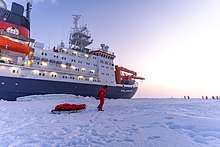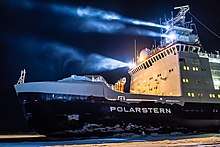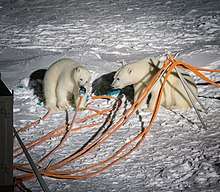MOSAiC Expedition
The Multidisciplinary drifting Observatory for the Study of Arctic Climate (MOSAiC, /ˌməʊˈzɛɪɪk/) expedition is a one-year-long expedition into the Central Arctic, planned to take place from 2019 to 2020.[1][2] For the first time a modern research icebreaker will operate in the direct vicinity of the North Pole year round, including the nearly half year long polar night during winter.[3] In terms of the logistical challenges involved, the total number of participants, the number of participating countries, and the available budget, MOSAiC represents the largest Arctic expedition in history.[1]

During its one-year-long journey, the central expedition ship, the research icebreaker Polarstern from Germany's Alfred Wegener Institute, Helmholtz Centre for Polar and Marine Research (AWI), will be supported and resupplied by the icebreakers and research vessels Akademik Fedorov and Kapitan Dranitsyn (Russia), Sonne and Maria S. Merian (Germany) and Xue Long II (China). In addition, extensive operations involving helicopters and other aircraft are planned.[2] In total, during the various phases of the expedition, more than 600 people will be working in the Central Arctic.[4] The international expedition, which will involve more than 80 institutions from 20 countries, will be conducted by the AWI and is led by the polar and climate researcher Markus Rex. MOSAiC's main goals are to investigate the complex and still only poorly understood climate processes at work in the Central Arctic, to improve the representation of these processes in global climate models, and to contribute to more reliable climate projections.[5]
The expedition will cost 140 Million Euros (approximately 154 Million USD); half of the budget is provided by the German Federal Ministry of Education and Research (BMBF). U.S. participation is primarily supported by the National Science Foundation, which is contributing roughly $24 million to the project, making among the largest Arctic research initiatives the agency has ever mounted. The Department of Energy is also highly invested in the mission, funding nearly $10 million and providing the largest suite of atmospheric instruments.
The MOSAiC expedition

In the half-year-long Arctic winter, the sea ice is too thick for research icebreakers to penetrate. Consequently, data from the Central Arctic is virtually non-existent, particularly during winter. For reaching the Central Arctic in winter, the MOSAiC expedition will follow in the footstep of Fridtjof Nansen's famous expedition with the wooden sailing ship Fram in the years 1893–1896, over 125 years ago.[6] His daring voyage showed that it was possible to let a ship drift across the polar cap, from Siberia to the Atlantic, stuck in the thick sea ice and solely driven by the forces of the natural drift of the ice. Though Nansen has demonstrated the fundamental feasibility of such an endeavour, the scientific measurements possible in his days were still quite rudimentary. During MOSAiC, for the first time the Fram’s drift will be repeated with a research icebreaker, equipped with a veritable arsenal of cutting-edge instruments for exploring and recording the complex climate processes in the Central Arctic.

The heart of MOSAiC will be Polarstern’s one-year-long drift through the Central Arctic. On 20 September 2019 the ship will depart from the Norwegian port of Tromsø together with the Akademik Fedorov, proceed east along the Siberian coast, and at roughly 125° East, turn north and begin breaking into the sea ice of the Central Arctic, which will still be feasible at that time of year. Once she reaches about 85° North, Polarstern will put her engines in neutral and allow herself to become trapped in the sea ice. An extensive research camp will then be set up all around the ship on the ice. At the same time, Akademik Fedorov will deploy a network of research stations on the ice, some as far as 50 km from Polarstern’s position. The network will consist of both autonomous and remote-controlled instruments, which will be checked at regular intervals using helicopter flights from the central Polarstern, which forms the Central Observatory.[7][8]
After delivering one last load of fuel, at the end of October Akademik Fedorov will return to Tromsø. From this point on, the natural drift will carry Polarstern and its network of research stations across the North Pole region. After a year, the ship will reach the Fram Strait, free herself from the ice, and return to her homeport in Bremerhaven by mid-October. At the beginning of the expedition, and from the summer of 2020, ice conditions will allow the MOSAiC partner icebreakers to reach Polarstern for resupply and personnel exchanges; in the phase from mid-February to mid-June, the ice will be too thick.
During the period March/April the German research aircraft Polar 5 and Polar 6, operating out of Svalbard and Greenland, will land and refuel on a runway created on the sea ice near Polarstern, complementing the expedition data with Arctic wide measurements. The sea-ice landing strip will also be used for delivering provisions and supplies, and for exchanging staff.[8][9]
Fuel depots set up on islands off the coast of Siberia specifically for the expedition will support potential emergency operations by long range helicopters, which will be able to reach Polarstern in the event of an emergency at least during the early and late phases of the expedition.[8]
Research focus areas
The primary goal of MOSAiC is to understanding the coupled climate processes in the Central Arctic, so that they can be more accurately integrated into regional and global climate models. The findings will contribute to more reliable climate projections for the Arctic and globally, to improved weather forecasts and better Arctic sea ice forecasts.[5][10]
In addition, the outcomes of the MOSAiC mission will help to understand the regional and global effects of Arctic climate change and the loss of sea ice.[11] They will improve the preparedness of communities in the Arctic and northern mid-latitudes, provide the scientific basis for the development of policies for a sustainable development of the Arctic and support fact based decision-making in the areas of mitigation of and adaptation to global climate change.[7][10]
Atmosphere
The comprehensive and complex atmospheric measurements carried out during MOSAiC will provide a physical basis for understanding local and vertical interactions in the atmosphere and the interactions between the atmosphere, the sea ice and the ocean. The characterisation of processes in clouds, in the atmospheric boundary layer, surface layer and surface energy flux will lead to a better understanding of the lower troposphere, which interact with the surface in the Arctic. One of the greatest challenges will be taking carrying out these measurements consistently throughout the sea ice’s entire annual cycle, especially at the beginning of the freezing period, so as to monitor the transition from open water to a very thin ice layer. Readings taken at higher altitudes will provide insights into the characteristics of the middle and upper troposphere and the interaction with the stratosphere. To improve our understanding of aerosols and aerosol-cloud interactions over the Central Arctic, especially in winter, measurements will be taken on the composition of the particles, their physical properties, their direct and indirect radiation effects, and their interactions with cloud properties.[7] Routine radiosonde observations in combination with tethered balloon measurements will provide high-resolution profiles of the atmospheric conditions in the column of air above the MOSAiC site. In addition, radar measurements will be used to determine the vertical profile of wind speed and direction as well as key cloud properties, including ice and liquid water content. Key thermodynamic parameters, as well as the kinematic structures of the atmosphere, will be investigated with the aid of microwave and infrared radiometers, Raman and Doppler lidar.
Sea-ice
The sea-ice observations will cover the broad range from the physical and mechanical characteristics of Arctic sea ice, to its morphology, optical properties and mass balance. The emphasis will be on characterising snow cover and ice cover, and on arriving at a better understanding of the processes that determine their properties. Snow trenches and ice cores will help the researchers gather this valuable data. Further aspects of the sea ice observation will include determining the mass budget by measuring the depth of snow cover and ice thickness, as well as measuring the diffusion of sunlight in the ice, the ice's spectral albedo, and its transmission. In addition, various types of ice will be monitored throughout the entire annual cycle in order to determine the spatial variability and development of ice cover in the Arctic over time.[7][8]
Ocean
Ocean processes influence the energy balance in the Arctic, as well as the growth and melting of sea ice due to additional warmth. They also play an important role in the biological activity that binds and potentially exports CO2. Measurements from the water column will shed new light on key mechanisms occurring in the ocean, e.g.: (1) heat exchange between sea ice and ocean, (2) absorption of sunlight and processing of the resulting heat, (3) interaction with deep sea processes, and (4) primary biological productivity and export of organic matter from the euphotic zone.
Given that understanding the evolution of sea ice is one of the primary goals of the MOSAiC expedition, ocean processes affecting the ice, like near-surface mixing, are at the heart of the oceanographic investigations. In addition, the dynamics and thermodynamics of the mixing layer will be explored in detail.[7] For this purpose, continuous measurements will be taken of turbulent fluxes directly below the ocean-ice boundary, to help understand the speeds of the ice and ocean, vertical thermal and momentum flows, diffusion of mass and other key processes. Moreover, the deep ocean will be observed in the broader context by creating profiles of the flow speed, temperature, salinity and dissolved oxygen in the top hundred metres of the Arctic Ocean on a regular basis, so as to better grasp its effects on the upper ocean-ice boundary layer.[8]
Ecosystem and Biogeochemistry
The observations on biological and biogeochemical transformation and succession will mainly focus on analysing samples from all three major physical regimes, i.e., the ice, snow and water environments. Additionally flow measurements will be conducted at both the ice/water and ice/air boundary layers. These will be repeated throughout the entire Arctic year in order to quantify the biology and biogeochemistry of the sea-ice/atmosphere system at every time of year, especially in the under-researched Arctic winter. For example, the annual mass budget for organic and inorganic carbon will be monitored, and crystallographic readings will be taken on the ikaite in seafloor channels.[8] The latter will offer insights into the biogeochemistry of the net air/ice flow of CO2 produced by sea ice, and into the potential for capturing organic carbon and the respiration of CO2. A second goal is to quantify the methane accumulation, the oxidation below the sea ice, and the air/ocean flows with regard to the potential for major oceanic methane flows into the atmosphere. A third key element: observing the cycles of biogenic gases like N2O, O2, DMS (dimethyl sulphide) and bromoform in the snow, sea ice and water, which will contribute to our grasp of the underlying biogeochemical paths.[8] An additional important aspect is the creation of an annual mass balance and ice/water cycle for macro- and micronutrients; in this regard, vertical nutrient flows between the ocean, euphotic zone, mixed and deep layers of the ocean will be investigated, in part with the aid of molecular tools, to arrive at a better understanding of the recycling chains.
Model implementation
A closely interlinked modelling and observation concept was central to the definition and planning of the MOSAiC expedition. In order to understand and explain the changes at work in the Arctic climate system, new models will be developed, and previous models will be refined, on the basis of the observations and readings taken during the expedition. These observations will also play an important part in improving these models and developing new ones for weather and sea-ice forecasting, and for climate projections. In turn, the models will offer insights into phenomena that are not directly observable. The observations made throughout MOSAiC will provide new framework conditions for models at various scales; e.g. high-resolution models will be used for detailed studies, and these studies can provide the basis for improving regional and global climate models.[2]
In addition, regional Arctic models will be used to answer important questions concerning the Arctic’s role as a global energy sink; how global connection patterns will be shaped by the changing ice volume in the Arctic; and how these changes will affect the circulation and weather in the lower latitudes.[2] The modelling and observations during MOSAiC will be conducted in close cooperation with the international modelling efforts of the World Weather Research Programme and World Climate Research Programme.
MOSAiC School 2019
The first phase of the expedition will feature a six-week course for 20 postgraduate students aboard Akademik Fedorov. This is jointly delivered by MOSAiC Partners and the Association of Polar Early Career Scientists.[12]
References
- "MOSAiC - Multidisciplinary drifting Observatory for the Study of Arctic Climate". www.mosaic-expedition.org. Retrieved 2019-06-12.
- "The Expedition - MOSAIC". www.mosaic-expedition.org. Retrieved 2019-06-12.
- Meyer, Robinson (2017-09-05). "A Year on Ice". The Atlantic. Retrieved 2019-06-12.
- "The Expedition in numbers - MOSAIC". www.mosaic-expedition.org. Retrieved 2019-06-12.
- Kaplan, Sarah (10 June 2019). "Adrift in the Arctic". Washington Post. Retrieved 12 June 2019.
- Devlin, Hannah (2017-02-20). "Scientists to repeat 19th-century ship's crossing of polar ice cap". The Guardian. ISSN 0261-3077. Retrieved 2019-06-12.
- MOSAiC Science Plan (PDF). Alfred Wegener Institute (AWI) / International Arctic Science Committee (IASC). 2016. Archived from the original (PDF) on 2019-03-29. Retrieved 2019-04-03.
- MOSAiC Implementation Plan (PDF). Alfred Wegener Institute (AWI). 2018. Archived from the original (PDF) on 2019-03-29. Retrieved 2019-04-03.
- Amos, Jonathan (2017-02-20). "Ice-locked ship to drift over North Pole". Retrieved 2019-06-12.
- "The Science - MOSAIC". www.mosaic-expedition.org. Retrieved 2019-06-12.
- "BBC World Service - Newshour, Why scientists want their boat to get stuck in Arctic ice". BBC. Retrieved 2019-06-12.
- "MOSAiC School 2019". Association of Polar Early Career Scientists. Retrieved 21 January 2019.
External links
- Official Website of the MOSAiC expedition
- Follow MOSAiC expedition (Progressive Web App)
- "Arctic researchers will lock this ship in ice for a year to study the changing polar region", Science Magazine, Aug. 20, 2019
- Interview with project leader Markus Rex from Alfred Wegener Institute (AWI)